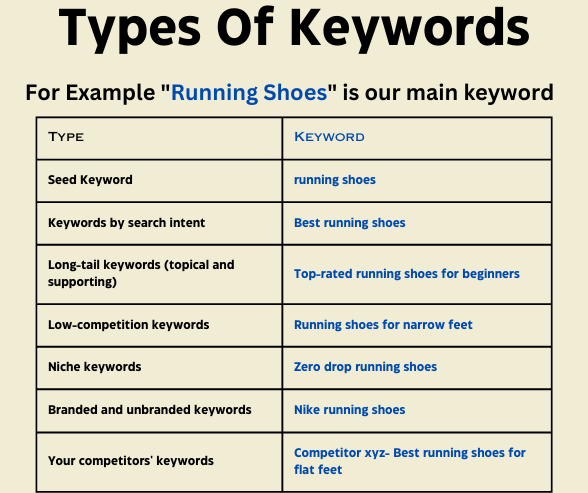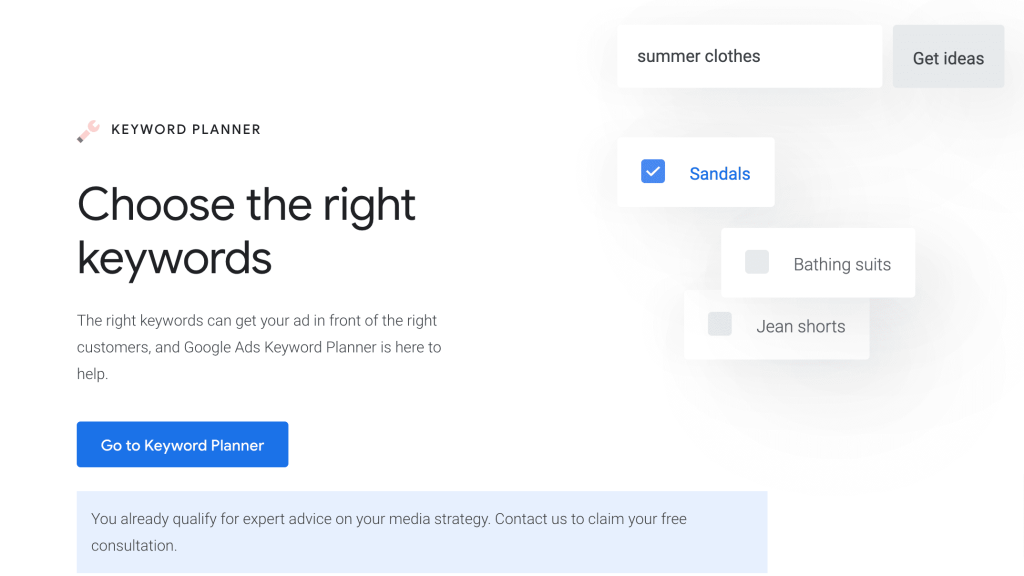SEO keywords, or search terms, are more than mere words; they are the link that connects your audience’s intent to the solutions that your content provides. The challenge is to identify these golden links and to wield them effectively.
In this guide, we demystify the process of keyword research, offering you step-by-step advice on how to find, choose, and implement the most effective keywords for your SEO strategy.
What are SEO Keywords?
SEO keywords are the words and phrases that people use to search for a particular product, service, or information on search engines. These keywords are essential for website owners because they help search engines understand what your website is about and rank it accordingly in search results. Using relevant keywords on your website’s content, meta tags, and descriptions can improve your website’s visibility and increase traffic.
Types of Keywords in SEO
Here are different types of keywords you would likely see in SEO terms.

1. Seed keywords:
These are the most basic terms that define your website or product. Using seed keywords is important because it helps search engines and potential customers understand what your website or product is all about. For example, if you own a coffee shop, “coffee” would be a seed keyword.
Other examples of seed keywords could be “running shoes” for a sports store or “organic makeup” for a cosmetics company.
2. Keywords by search intent:
These are keywords that suggest the searcher’s intent behind their search. By using keywords that match the searcher’s intent, you can improve the relevance of your content.
For example, “buy coffee online” is a keyword that suggests the searcher is looking to make a purchase, while “how to make coffee” suggests the searcher is looking for information.
Other examples of keywords by search intent could be “best coffee shops in [city]” for someone looking for local recommendations or “coffee recipes” for someone looking for new ways to enjoy their coffee.
3. Long-tail keywords (topical and supporting):
These are highly specific keyword phrases that are often longer than three words. Using long-tail keywords can help you target a specific audience and attract more qualified traffic to your website.
For example, “best coffee shops near Times Square” is a long-tail keyword that could help a coffee shop in that area attract more customers. Other examples of long-tail keywords could be “vegan coffee shops in [city]” or “coffee shops with free Wi-Fi.”
4. Low-competition keywords:
These are keywords that are not very competitive, meaning it’s easier to rank for them in search results. By targeting low-competition keywords, you can improve your chances of ranking higher in search results and attracting more traffic to your website.
For example, “best coffee shops in a specific small town” could be a low-competition keyword that a small coffee shop could target to attract more local customers. Other examples of low-competition keywords could be “coffee shops with outdoor seating” or “coffee shops with live music.”
5. Niche keywords:
These are keywords that relate to a very specific topic or industry. By targeting niche keywords, you can attract a highly targeted audience and establish yourself as an authority in your industry.
For example, “organic coffee” is a niche keyword that could be used by a coffee shop that specializes in organic, fair-trade coffee. Other examples of niche keywords could be “gluten-free coffee” or “coffee for athletes.”
6. Branded and unbranded keywords:
Branded keywords include your business name or product name. Unbranded keywords don’t include these names. By using a combination of branded and unbranded keywords, you can improve your visibility in search results and attract both new and returning customers to your website.
For example, “Starbucks” is a branded keyword, while “coffee shops near me” is an unbranded keyword. Other examples of branded keywords could be “Starbucks coffee” or “Starbucks menu,” while other examples of unbranded keywords could be “coffee delivery” or “coffee subscriptions.”
7. Your competitors’ keywords:
These are keywords that your competitors are targeting. By analyzing your competitors’ keywords, you can identify new opportunities to target and improve your own keyword strategy.
For example, if you’re a coffee shop, you might want to target the same keywords as other coffee shops in your area, such as “coffee shops in [city]” or “best coffee in [neighborhood].” Other examples of your competitors’ keywords could be “coffee shop chains” or “coffee shop franchises.”
8. Primary and secondary keywords:
Primary keywords are the most important keywords for your website or product. Secondary keywords are still important but not as critical. By prioritizing your primary keywords, you can ensure that your website or product is properly optimized for search engines and potential customers.
For example, if you own a coffee shop, “coffee” would be a primary keyword, while “pastries” might be a secondary keyword. Other examples of primary keywords could be “coffee beans” or “coffee roasting,” while other examples of secondary keywords could be “tea” or “smoothies.”
It’s important to choose the right keywords for your website or product in order to improve your SEO and drive traffic. Combining several of these keyword types can help you create a well-rounded keyword strategy that targets a variety of potential customers.
Why is Keyword Research Important?
Finding relevant keywords is a crucial step in any successful SEO strategy. It involves identifying the phrases and words that users use to search for information on the internet. Here are some reasons that make keyword research an essential practice for SEO:
1. Helps to understand the target audience
Keyword research provides insights into the language that visitors uses when searching for info related to your business. By understanding the keywords they use, you can create content that matches their search intent, leading to higher engagement and conversions.
2. Improves website traffic
By optimizing your website for the right keywords, you can improve your website’s visibility on search engines. This will help to attract huge traffic to your site, increase brand awareness, and generate leads.
3. Enhances content marketing
Keyword research can help you identify the topics and themes that your target audience might be interested in. By creating content that addresses their needs and interests, you can establish your brand as an authority in your industry.
4. Outrank competitors
You can identify your competitors’ weaknesses and gaps by spying on and analyzing their targeted keywords. It will help you capitalize on the opportunity, and you can also outrank them in the search results.
5. Provides insights for product development
Keyword research can also help you understand what products or services people are interested in. This can help you create new products or services that meet their needs and preferences.
6. Identifies seasonal trends
Keyword research can help you identify seasonal trends in your industry. By optimizing your content for these trends, you can attract more traffic to your website during peak seasons.
7. Helps to optimize for voice search
Keyword research can help you identify the long-tail keywords and phrases that people use when conducting voice searches. By optimizing your content for these phrases, you can improve your visibility in voice search results.
Step-by-Step Guide to Find Keywords for SEO
Here is a step-by-step guide for conducting keyword research for SEO:
Step 1. Study your niche
The initial step in keyword research is to understand your niche or industry. You need to know what your niche is all about, what the common topics are, and what kind of products or services are being offered. It helps you create relevant content that is valuable to your audience.
Suppose your niche is “fitness,” you need to know the different types of fitness, such as weightlifting, cardio, and yoga. You should also know what people in your niche are interested in, such as healthy eating, workout routines, or supplements. You can do this by researching blogs, forums, and social media groups related to your niche.
Step 2. Define your goals
The next step is identifying your goals. What do you want to achieve with your content? Do you want to drive traffic to your website, generate leads, or sell products? This step helps you create a targeted keyword strategy.
For example, if your goal is to sell products, you’ll want to target keywords that are related to your products, such as “protein powder,” “workout clothes,” or “yoga mats.” If your goal is to generate leads, you might target keywords related to free trials, sign-ups, or email subscriptions.
Step 3. Make a list of relevant topics
After you’ve defined your goals, you should make a list of relevant topics. These are broad areas that you might want to cover in your content. The topics should be related to your niche and aligned with your goals.
If your niche is “fitness,” some relevant topics might be “workout routines,” “healthy eating,” or “supplements.” You can use tools like Google Trends or Google AdWords Keyword Planner to identify popular topics related to your niche.
Step 4. Create a list of seed keywords
Seed keywords are the foundation of your keyword research. These are the words or phrases that you want to rank for in search engines. You can start with broad keywords related to your niche and then use reliable tools to identify more specific keywords.
For example, if your niche is “fitness,” some seed keywords might be “weightlifting,” “cardio,” or “yoga.” Tools like Ahrefs and SEMrush come in handy when it comes to finding related keywords, search volume, and competition data.
Step 5. Use good keyword research tools
There are many tools available for keyword research, such as Ahrefs, Google Keyword Planner, or SEMrush. These tools can help you find related keywords, search volume, and competition data. Some of these tools are free, while others require a subscription.
For instance, you can use Google Keyword Planner to find keyword ideas and search volumes. Ahrefs and SEMrush can help you analyze your competitors’ websites and find out which keywords they are targeting.
Step 6. Study the search intent
Search intent is the reason behind a searcher’s query. It’s important to understand what people are looking for when they search for a particular keyword. This will help you create content that meets their needs.
If someone searches for “yoga mats,” they might be looking to buy a yoga mat, while someone searching for “yoga poses” might be looking for instructional videos or articles. You can use Google to analyze the search results for your target keywords and see what kind of content is ranking.
Step 7. Identify long-tail keywords
These keywords tend to be less competitive than broader keywords. They usually consist of four or more words and are more likely to convert into leads or sales. Long-tail keywords can help you target a specific audience and improve your chances of ranking higher in search results.
Instead of targeting the broad keyword “yoga,” you might target the long-tail keyword “yoga for beginners near me.” You can use keyword research tools to find long-tail keywords related to your niche and goals.
Step 8. Find out about your competitors
It’s important to know who your competitors are and what keywords they are targeting. You can use tools like Ahrefs or SEMrush to analyze their websites and see which keywords they are ranking for. This will help you identify opportunities to target similar keywords or create content that is more valuable than your competitors.
Step 9. Analyze the data and select your keywords
After you’ve collected all the data, you need to analyze it and select the keywords that are most relevant to your goals and niche. You should consider factors like search volume, competition, and relevance. You can use a spreadsheet or keyword research tool to organize your data and compare different keywords.
Step 10. Optimize your content for your selected keywords
Once you’ve selected your keywords, you need to optimize your content for them. This includes adding them to your titles, meta descriptions, headers, and body copy. Optimizing your content for your keywords can help search engines understand what your content is about and improve your chances of ranking higher in search results. Make sure to avoid keyword stuffing and focus on creating high-quality, valuable content that meets the needs of your audience.
Using SEO Keywords for Content Optimization
Once you’ve identified your keywords, you need to use them effectively on your site. Here are some proven tips for using SEO keywords for content optimization:
1. Titles:
Including your keywords in your titles can help search engines understand what your content is about and improve your chances of ranking higher in search results. However, make sure your titles are still catchy and attention-grabbing for human readers. Avoid stuffing too many keywords in your titles, and keep them concise and relevant.
2. Meta descriptions:
Your meta descriptions provide a brief summary of your article to search engine users. Including your keywords in your meta descriptions can help enhance your CTR (click-through rates). However, make sure your meta descriptions are still informative and compelling for human readers. Again, avoid stuffing too many keywords in your meta descriptions and keep them concise and relevant.
3. Headers:
You can use keywords in your headers to break up your content and make it easier for users to read. It can also help search engines understand the structure of your content. Use H1 tags for your main title and H2 or H3 tags for your subheadings. Make sure your header tags are descriptive and contain relevant keywords.
4. Body copy:
Including your keywords in your body copy can help search engines understand what your content is about and improve your chances of ranking higher in search results. However, don’t overdo it and stuff too many keywords in the content. Use your keywords naturally and make sure your content is still readable and engaging for human readers.
5. Image alt tags:
Including your keywords in your image alt tags can help improve the accessibility of your content and provide additional context to search engines. Alt tags are also used by screen readers for visually impaired users. Make sure your alt tags are descriptive and contain relevant keywords.
Best Keyword Research Tools for SEO
If you want to narrow down your research for relevant keywords for SEO, consider using a keyword research tool. The internet is filled with these tools. But here are some popular tools suggested by professionals:
1. SEMrush
SEMrush is a popular SEO tool that offers a range of features, including keyword research, site audit, and backlink analysis. Its keyword research tool provides detailed information on keyword difficulty, search volume, and related keywords. The tool also allows users to track their keyword rankings and monitor their competitors’ performance.

2. Ahrefs
Ahrefs is another powerful SEO tool that offers a comprehensive keyword research feature. It provides information on keyword difficulty, search volume, and the top pages ranking for a given keyword. Ahrefs also offers features such as site audit, backlink analysis, and content analysis.
Also Read: Key Differences between Semrush vs Ahrefs
3. Google Keyword Planner
Google Keyword Planner is a free tool that allows users to search for keywords related to their business. It provides information on search volume, competition, and suggested bids for AdWords campaigns. The tool is easy to use, and it offers valuable insights into keyword trends and search behavior.

4. Ubersuggest
Ubersuggest is a free keyword research tool that provides users with keyword suggestions and related keywords. It also provides information on search volume, competition, and CPC (cost per click). The tool is easy to use, and it provides valuable insights into the keywords that potential customers use to find products or services online.
5. Keyword Tool
Keyword Tool is a paid keyword research tool that provides users with keyword suggestions and related keywords for Google, Bing, YouTube, and Amazon. It also provides information on search volume, CPC, and competition. The tool is easy to use, and it offers valuable insights into keyword trends and search behavior.

Related Reads:
Conclusion– How to find keywords for SEO
In conclusion, keyword research is a fundamental aspect of any successful SEO strategy. It involves understanding your audience’s search behavior and aligning your content to their needs. By using the right keywords effectively, you can capture organic traffic and propel your brand to new heights.
With the step-by-step guide and list of tools provided in this article, you can get started on your own keyword research journey and optimize your website for the right keywords. Remember to always prioritize your human readers and create valuable, engaging content that meets their needs.


